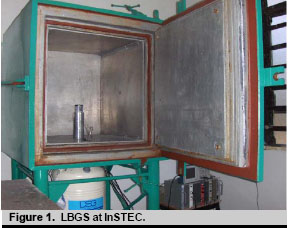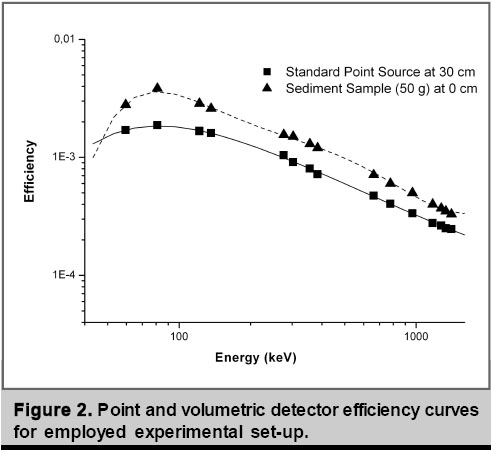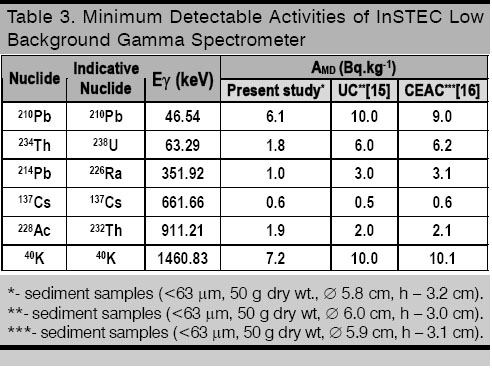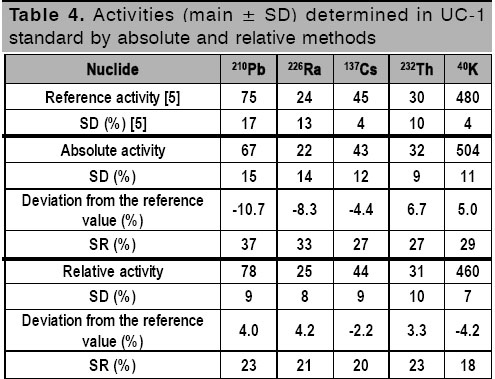Mi SciELO
Servicios Personalizados
Revista
Articulo
Indicadores
-
 Citado por SciELO
Citado por SciELO
Links relacionados
-
 Similares en
SciELO
Similares en
SciELO
Compartir
Nucleus
versión impresa ISSN 0864-084X
Nucleus n.46 Ciudad de La Habana jul.-dic. 2009
CIENCIAS NUCLEARES
Characterization of the InSTEC’s low-background gamma spectrometer for environmental radioactivity studies
Caracterización del espectrómetro gamma de bajo fondo del INSTEC para estudios de radioactividad ambiental
Oscar Díaz Rizo 1 , Neivy López Pino 1 , Katia D´Alessandro Rodríguez 1 , Henry Reyes 1 , Cármen Ródenas Palomino 2 , Fátima Padilla Cabal 1 , Juana Orquídea Arado López, Amalia Ofelia Casanova Díaz 1 , Alina Gelen Rudnikas 1 , José Gómez Arozamena 2 .
1 Instituto Superior de Tecnologías y Ciencias Aplicadas (InSTEC)
Ave. Salvador Allende y Luaces, POB 6163, Habana 10600, Cuba
2 Universidad de Cantabria (UC), Ave. Los Castros s/n, Santander, España.
odrizo@instec.cu
ABSTRACT
The capabilities of the LowBackground Gamma Spectrometer (LBGS) at InSTEC were studied for environmental purposes. Fifty three glines were identified in the LBGS background spectrum. The Minimum Detectable Activity for ![]() ,
, ![]() ,
, ![]() ,
, ![]() ,
, ![]() and
and ![]() were calculated using the detector’s volumetric efficiency simulated by Monte Carlo method. Validation was performed by absolute and relative analysis of radionuclide activities present in a marine sediment certified material.
were calculated using the detector’s volumetric efficiency simulated by Monte Carlo method. Validation was performed by absolute and relative analysis of radionuclide activities present in a marine sediment certified material.
RESUMEN
Se determinan las potencialidades del Espectrómetro Gamma de Bajo Fondo del InSTEC con fines ambientales. Se identificaron 53 líneas gamma en el espectro de fondo natural del espectrómetro. Se calculan las actividades mínimas detectables para los radionucleidos ![]() ,
, ![]() ,
, ![]() ,
, ![]() ,
, ![]() and
and ![]() empleando la eficiencia volumétrica del detector simulada por Monte Carlo. Como validación se determinan, por vía absoluta y relativa, las actividades de los radionucleidos presentes en un estándar de sedimento marino.
empleando la eficiencia volumétrica del detector simulada por Monte Carlo. Como validación se determinan, por vía absoluta y relativa, las actividades de los radionucleidos presentes en un estándar de sedimento marino.
Key words: background radiation, gamma spectroscopy, Monte Carlo method, gamma spectrometers
Introduction
A large number of users of gamma spectrometry are concerned with measuring low levels of radioactivity such as those present in environmental samples (soils, sediments, water, food, etc.). There is a constant pressure to resolve lower and lower concentration levels. For this reason, the experimental set-up to be used for environmental radioactivity studies needs as low as possible the Minimum Detectable Activity (![]() ). The
). The ![]() is defined as the minimum amount of radioactive nuclide which can be determined [1]. It may vary with the amount, type and geometry of the sample and nuclide identity, as well regarding the detector (type, crystal dimension, energy resolution, etc.), detector environment (background) and counting time, i.e. the
is defined as the minimum amount of radioactive nuclide which can be determined [1]. It may vary with the amount, type and geometry of the sample and nuclide identity, as well regarding the detector (type, crystal dimension, energy resolution, etc.), detector environment (background) and counting time, i.e. the ![]() have a strong dependence with the detector efficiency and the radioactive background. Taking these facts into account, to characterize a gamma spectrometer destined to environmental studies, a detector efficiency well known and a radioactive background minimization are indispensable.
have a strong dependence with the detector efficiency and the radioactive background. Taking these facts into account, to characterize a gamma spectrometer destined to environmental studies, a detector efficiency well known and a radioactive background minimization are indispensable.
The experimental determination of the detector efficiency for volumetric samples (typical in environmental studies) is not a simple problem. A set of volumetric certified gamma sources (with density, composition and gamma energy range similar to the samples of interest) is needed, but they are either too expensive or not for sale. An alternative way is starting from the detector efficiency using a set of point standard sources (for example, ![]() ,
, ![]() ,
, ![]() ,
, ![]() and
and ![]() ), compute the point (
), compute the point (![]() (
(![]() )) and volumetric (
)) and volumetric (![]() (
(![]() )) energy-dependent solid angles by Monte Carlo simulations [2] or by a Semiempirical Method [3], and calculate the volumetric efficiency as follow:
)) energy-dependent solid angles by Monte Carlo simulations [2] or by a Semiempirical Method [3], and calculate the volumetric efficiency as follow:

On the other hand, unwanted background radiation is originated from radionuclides in the detector assembly and those in surround materials, radionuclides in air and cosmic ray interactions with both the detector itself and with surrounding materials. Background reduction methods have been categorized as «active» and «passive». «Active» procedures block potential background counts in the spectrum dynamically on a pulse-by-pulse basis [1]; «passive» methods use absorption in graded shields, by selecting low activity materials with different atomic number (Z) in order to absorb the high and low energy gamma radiation, X-rays from the shield materials and cosmic rays reaction products.
The aim of the present study is to evaluate the capabilities of the recently installed Low-Background Gamma Spectrometer (LBGS) at InSTEC for environmental radioactivity studies by the measure of the spectrometer background, the ![]() and the detector efficiency; also the activity of the nuclides present in marine sediment standard is determined.
and the detector efficiency; also the activity of the nuclides present in marine sediment standard is determined.
Material and Methods
Low-Background Gamma Spectrometer: The LBGS of the Nuclear Analytical Laboratory at InSTEC (figure 1) is composed by a Low-Background Chamber (LBC), using an n-type closed-end coaxial high-purity germanium detector (DSG, NGC-3018, 130 ![]() , FHWM = 2.04 keV for 1332 keV
, FHWM = 2.04 keV for 1332 keV ![]() gamma line) equipped with an 8192 channel multichannel analyser (webMASTER TARGET coupled to PC). The gamma spectra are processed using the Gamma-W version 18. 03 code (Dr. Westmeier Gesellschaft für Kernspektrometrie mbH). The LBC is a detector shielded with 55 mm thickness of lead, 35 mm thickness of a steel frame, and an internal graded shielding consisting of 12 mm thickness of cadmium, 17 mm of copper and 9 mm of aluminium. The inner dimensions of the LBC are 800 mm depth X´718 mm width X´736 mm height.
gamma line) equipped with an 8192 channel multichannel analyser (webMASTER TARGET coupled to PC). The gamma spectra are processed using the Gamma-W version 18. 03 code (Dr. Westmeier Gesellschaft für Kernspektrometrie mbH). The LBC is a detector shielded with 55 mm thickness of lead, 35 mm thickness of a steel frame, and an internal graded shielding consisting of 12 mm thickness of cadmium, 17 mm of copper and 9 mm of aluminium. The inner dimensions of the LBC are 800 mm depth X´718 mm width X´736 mm height.
Sample preparation: In the present study, we have used the certified reference material (CRM) IAEA-375 [4] and the marine sediment standards UC-1 and UC-2, prepared in the University of Cantabria (Spain) [5]. Their radionuclide activities and main characteristics of the corresponding analytical lines are presented in table 1. Sample preparation was carried out by experimentally standardized the samples at 50 grams (dry weight), and stored on a hermetic closed plastic carried out 28 days after sample preparation (to guarantee the secular equilibrium of the U and Th daughters) during 24 hours.
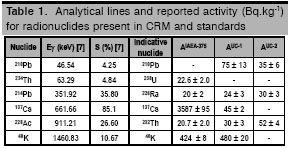
Minimum Detectable Activity (![]() ): The LBGS background spectrum was measured during 72 hours for
): The LBGS background spectrum was measured during 72 hours for ![]() determination. For each radionuclide, the
determination. For each radionuclide, the ![]() was calculated as:
was calculated as:

where ![]() is the spectrometer detection limit defined by Currie [6] equal to 3
is the spectrometer detection limit defined by Currie [6] equal to 3![]() , where s is the standard deviation (in counts) of the area of the background windows (peak window at 1.17 times the FWHM), t the counting time,
, where s is the standard deviation (in counts) of the area of the background windows (peak window at 1.17 times the FWHM), t the counting time, ![]() the absolute emission probability corresponding to the i-th gamma-ray for the nuclide j and
the absolute emission probability corresponding to the i-th gamma-ray for the nuclide j and ![]() (
(![]() ) is the volumetric detection efficiency of the full-energy absorption peak considered.
) is the volumetric detection efficiency of the full-energy absorption peak considered. ![]() is the energy corresponding to the i-th gamma-ray for the nuclide j.
is the energy corresponding to the i-th gamma-ray for the nuclide j.
The volumetric efficiency was determined by semiempirical method using Monte Carlo (MC) simulation and point standard sources (![]() ,
, ![]() ,
, ![]() ,
, ![]() and
and ![]() ), produced by AEA Technology QSA GmbH. Simulations were carried out to compute the point (
), produced by AEA Technology QSA GmbH. Simulations were carried out to compute the point (![]() (
(![]() )) and volumetric (
)) and volumetric (![]() (
(![]() )) energy dependent solid angles of Eq. (1). The MCNPX 2.5 was used as simulation code [8]. It has been used widely to estimate the efficiency curve of HPGe detectors for volumetric samples [9-12]. The sample-detector configuration was exactly reproduced in the MC simulation, taking as data the dimensions, density and chemical major elemental composition of CRM and standards, as well as the detector specifications (Ge crystal dimensions, dead layer and Al thickness, distance from Ge crystal to Al end cap) provided by detector supplier.
)) energy dependent solid angles of Eq. (1). The MCNPX 2.5 was used as simulation code [8]. It has been used widely to estimate the efficiency curve of HPGe detectors for volumetric samples [9-12]. The sample-detector configuration was exactly reproduced in the MC simulation, taking as data the dimensions, density and chemical major elemental composition of CRM and standards, as well as the detector specifications (Ge crystal dimensions, dead layer and Al thickness, distance from Ge crystal to Al end cap) provided by detector supplier.
Activity Determination: For validation, the radionuclide activities present in UC-1 standard were determined by absolute method as:

where ![]() is the i-th photopeak area for the nuclide j; and by relative method calculated as:
is the i-th photopeak area for the nuclide j; and by relative method calculated as:

using the CRM IAEA-375 and UC-2 standard for calibration. The accuracy was evaluated using the SR criterion, proposed by McFarrell et al. [13]:

where ![]() – experimental activity,
– experimental activity, ![]() – certified value and
– certified value and ![]() is the standard deviation of
is the standard deviation of ![]() . On the basis of this criterion the similarity between the certified value and the analytical data obtained by proposed methods falls into three categories: SR
. On the basis of this criterion the similarity between the certified value and the analytical data obtained by proposed methods falls into three categories: SR![]() 25% = excellent; 25 < SR
25% = excellent; 25 < SR ![]() 50%= acceptable, SR > 50% = unacceptable.
50%= acceptable, SR > 50% = unacceptable.
Results and Discussion
Table 2 shows 52 gamma lines determined with an area error lesser than 30% in the 72 hours LBGS background spectrum. All of them were very well identified. The origin of the major percent of the observed ![]() -lines is the presence of different nuclides from U and Th decay families. A larger contribution is caused by bremsstrahlung from the b decay of the daughter
-lines is the presence of different nuclides from U and Th decay families. A larger contribution is caused by bremsstrahlung from the b decay of the daughter ![]() (
(![]() = 5.013 d,
= 5.013 d, ![]() =1161 keV), which is present in secular equilibrium. Independently of the copper and aluminium shield present in the LBC, the
=1161 keV), which is present in secular equilibrium. Independently of the copper and aluminium shield present in the LBC, the ![]() and
and ![]() Pb X-ray lines are observed. The biggest count rate (0,013 cps) was determined for the
Pb X-ray lines are observed. The biggest count rate (0,013 cps) was determined for the ![]() non-analytic 92.38 keV
non-analytic 92.38 keV ![]() -line.
-line.
During LBC construction, a difficulty with normal commercial Pb is that it can probably contain some ![]() , which originates in trace
, which originates in trace ![]() in lead ore, and it is important to mention that this lead isotope cannot be removed chemically in lead purification. For this reason, the use of low-level lead is more recommended. Verplancke [14] takes as «low-level lead» that lead with less than 10 Bq of
in lead ore, and it is important to mention that this lead isotope cannot be removed chemically in lead purification. For this reason, the use of low-level lead is more recommended. Verplancke [14] takes as «low-level lead» that lead with less than 10 Bq of ![]() per Pb kg. Considering the count rate observed for 46.54 keV
per Pb kg. Considering the count rate observed for 46.54 keV ![]()
![]() -line (0.006 cps) in the spectrometer background, the presence of low-level lead in the LBGS is confirmed. On the other hand, the presence of the non-natural radionuclide
-line (0.006 cps) in the spectrometer background, the presence of low-level lead in the LBGS is confirmed. On the other hand, the presence of the non-natural radionuclide ![]() was unexpected. This isotope usually is associated with the nuclear explosions occurred after 1945. Then, its presence must be associated to the use of non-sufficient old steel in the LBC construction.
was unexpected. This isotope usually is associated with the nuclear explosions occurred after 1945. Then, its presence must be associated to the use of non-sufficient old steel in the LBC construction.
Figure 2 shows the efficiency curves for point sources located at 30 cm of height (experimental), and for the 50 grams sediment sample at 0 cm. The last curve was obtained computing the energy-dependent solid angles by MC simulations and taking the 30 cm point efficiency as reference (Eq. 1). The low energy gamma rays self-absorption inside the volumetric sample is clearly observed. These curves were well fitted by the following polynomials:

The ![]() calculated by Eq.(2) for each radionuclide of interest after the 72 hours of background spectrum measurement are shown in table 3. The comparison with other similar gamma spectrometers (UC–University of Cantabria, Spain; CEAC–Center for Environmental Studies of Cienfuegos, Cuba) used for environmental studies shows that the InSTEC LBGS has the lowest detectable activities.
calculated by Eq.(2) for each radionuclide of interest after the 72 hours of background spectrum measurement are shown in table 3. The comparison with other similar gamma spectrometers (UC–University of Cantabria, Spain; CEAC–Center for Environmental Studies of Cienfuegos, Cuba) used for environmental studies shows that the InSTEC LBGS has the lowest detectable activities.
The activities of the UC-1 standard radionuclides determined in the InSTEC LBGS are shown in table 4.
The bigger dispersion (between 10-15%) and deviation from the reference value (between 4.4 – 10.7%) are observed for absolute analysis. This is in correspondence with the difficulties in detector volumetric efficiency calculation, especially for low energies (the bigger dispersions are obtained for analytical lines with energy less than 100 keV). To solve this problem, a finest data (for example, about sample composition) and/or large calculations during Monte Carlo simulation are necessary. Independently of the above criteria, the SR accuracy test shows values between 25 and 50% for all determined activities, i.e., using the absolute method we obtained «acceptable» results.
On the other hand, the application of the relative method shows «excellent» results (SR < 25% for all determined activities). For the studied radionuclides, the obtained deviation from the reference values is always less than 5%. It is an excellent precision for natural radioactivity measurements.
According to the obtained results, for environmental radioactive studies using InSTEC Low Background Gamma Spectrometer, relative measurements are more recommended. Unfortunately, this method requires certified standards with a matrix similar to the studied sample matrix. For environmental studies many different certified standards (soils, sediments, water, food, etc.) are needed. Therefore, the alternative way is the use of absolute measurements expecting, until now,
acceptable activity accuracy.
Conclusions
The Low-Background Gamma Spectrometer at InSTEC is an accurate facility for environmental radioactivity studies. The combination of low-level lead and Cd-Cu-Al internal graded shields allow obtaining a very low minimum detectable activity for those radionuclides of ecological interest. Relative and absolute activity measurements can be carried out with excellent and acceptable accuracies, respectively.
References
[1] GILMORE G, HEMINGWAY J. Practical Gamma-ray Spectrometry. John Wiley & Sons, 1995.
[2] VIDMAR T, AUBINEAU-LANIECE I, ANAGNOSTAKIS, et. al. An intercomparison of Monte Carlo codes used in gamma-ray spectrometry. Applied Radiat. Isot. 2008; 66(6-7): 764-768.
[3] LEPY MC, ALTZITZOGLOU T, ARNOLD D, et. al. Intercomparison of efficiency transfer software for gamma-ray spectrometry. Applied Radiat. Isot. 2001; 55(4): 493–503.
[4] IAEA. Intercomparison run IAEA-375: Determination of radionuclides in soil. Report IAEA/AL/075. Vienna: IAEA, 1994.
[5] GÓMEZ J, SOTO J. Ejercicio de intercomparación de resultados de medida de radiactividad en la Red de Vigilancia Radiológica Ambiental. Madrid: Consejo de Seguridad Nuclear, 1998. (in Spanish).
[6] CURRIE LA. Limits for quantitative detection and quantitative determination. Anal. Chem. 1968; 40(3): 586.
[7] FIRESTONE RB. Table of Isotopes. Wiley Interscience, 1996. Eighth edition.
[8] PELOWITZ DD. MCNPX TM User’s manual. LACP-05-0369. Version 2.5.0. Los Alamos National Laboratory Report, 2005.
[9] RÓDENAS J, MARTINAVARRO A, RIUS V. Validation of the MCNP code for the simulation of Ge-detector calibration. Nucl. Instr. Methods Phys. Res. A. 2000; 450(1): 88-97.
[10]KARAMANIS D. Efficiency simulation of HPGe and Si(Li) detectors in g- and X-ray spectroscopy. Nucl. Inst. and Meth. in Phys. Res. A. 2003; 505(1-2): 282-285.
[11]MARQUES SALGADO C, CONTI CC, BECKER PHB. Determination of HPGe detector response using MCNP5 for 20–150 keV X-rays. Applied Radiat. Isot. 2006; 64(6): 700–705.
[12]RÓDENAS J, GALLARDO S, BALLESTER S, et. al. Application of the Monte Carlo method to the analysis of measurement geometries for the calibration of a HP Ge detector in an environmental radioactivity laboratory. Nucl. Instr. Methods Phys. Res. B. 2007; 263(1): 144-148.
[13]QUEVAUVILLER PH, MARRIER E. Quality Assurance and Quality Control for Environmental Monitoring. Weinheim: VCH, 1995.
[14] VERPLANCKE V. Low level gamma spectroscopy: low, lower, lowest. Nucl. Instr. Methods Phys. Res. A. 1992; 312(1-2): 174-182.
[15]GELEN A, SOTO J, DÍAZ RIZO O, SIMON MJ, BELTRÁN J, RAMÍREZ M, HERRERA E, GÓMEZ J, RÓDENAS C. Radiological evaluation of sediments from the bay of Havana. Nucleus. 2002; (32): 17-22.
[16]ALONSO C. Environmental Radioactivity Sources, Distribution and Risk in Cuban Marine Ecosystem, Ph. D. Thesis. La Habana: InSTEC, 2010. (in Spanish)
Recibido: 3 de agosto de 2009
Aceptado: 12 de noviembre de 2009













